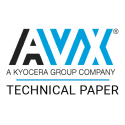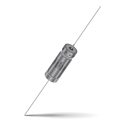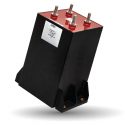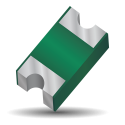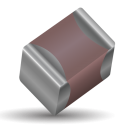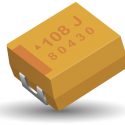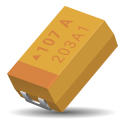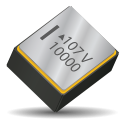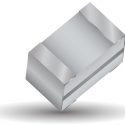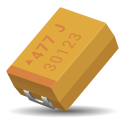Film Technology To Replace Electrolytic Technology Written By: Gilles Terzulli | Billy W. Peace Abstract: Since 1980, great improvements have been made on DC filter capacitors using a combination of metallized plastic films and different segmentations of the metallization on those film dielectrics. Volume and weight have been reduced by a factor of 3 or 4 over the last years. Now film manufacturers have developed thinner films and have improved segmentation techniques used on the metallization which has helped immensely in the improvement of such capacitors. Using non-gas impregnated designs, the voltage ranges between 600 VDC and 1200 VDC can be more economically covered by film capacitors rather than electrolytic. Depending on the application, over 1200 VDC, vegetable oil-filled versions
Resources
AVX TWA Series Wet Tantalum Capacitors DSCC 93026 & Beyond Written By: Brian Brunette Abstract: Wet tantalum capacitors have been utilized for many years in high energy storage applications where volumetric efficiency and high reliability are essential requirements. This paper describes the next generation of high CV (capacitance/voltage) wet tantalum technology which is enabling higher efficiency and higher reliability capacitor designs, extending application capabilities.
Energy and Power Handling Capabilities of Thin Film and Ceramic Capacitors Written By: Ben Smith Abstract: A continual growth of uncertainty and misconception has been prevalent in determining the power and energy capabilities of both ceramic and silicon capacitors. As today’s systems are subjected to increasingly more stringent requirements, designers are faced with numerous situations where the components that are used dictate design configurations. This paper addresses the concepts associated with a capacitor’s ability to withstand power and energy. Both theoretical and empirical models are developed and used to provide design guidelines.
Film Technology To Replace Electrolytic Technology in Wind Power Applications Written By: Gilles Terzulli Abstract: Aluminium electrolytic capacitors present serious challenges for the designer of high voltage power systems required in the very latest wind energy applications. In contrast, film technology offers significantly improved life expectancy, environmental performance and power handling capability.
Land Grid Array (LGA) Low Inductance Capacitor Advantages in Military and Aerospace Applications Written By: Sonja Brown Abstract: The benefits of Land Grid Array (LGA) capacitors and superior low inductance performance in modern military and aerospace designs.
Dielectric Absorption of Multilayer Organic (MLO™) Capacitors Written By: Edgardo Menendez Abstract: Capacitors with Dielectric Absorption (DA) recover some of their charge even after the capacitor has been fully discharged (see Figure 1). (Ref. 2) It is expressed in percentage and it is based on the measured voltage after discharging and charge recovery divided by the maximum voltage that was originally applied (see Equation 1)…
Introduction to Choosing MLC Capacitors For Bypass/Decoupling Applications Written By: Yun Chase Abstract: Methods to ensure signal integrity using decoupling capacitors have been the topic of many papers in the past as well as in the present. One can find equally many methods of decoupling as well. This paper will illustrate one of these established methods and introduce it in a theoretical sense using the most simplistic of terms. The paper will also describe the methods of the past (in slow speed systems) and the practices of the present (in high speed systems).
Application Guidelines on IR Reflow of Surface Mount Solid Tantalum Capacitors Written By: Steve Warden | John Gill Abstract: This paper tries to explain the factors which influence the ability of surface mount solid Tantalum capacitors to withstand present industry standard reflow technologies, and explores the peak temperature trends of industry IR reflow systems. *To assist you with the terminology used within this document a glossary is available through the AVX worldwide sales office
Analysis of Solid Tantalum Capacitor Leakage Current Written By: R. W. Franklin Abstract: The leakage current of a solid tantalum capacitor is the sum of several independent factors. From measurements of leakage over a range of test conditions some degree of separation of these components of the current can be achieved and so the relative importance of factors leading to high leakage can be assessed. There is a background level present directly related to dielectric absorption and it contributes to the loss factor of the capacitor. It is not a true leakage. On top of this absorption current there are other components, most of which are essentially by-passing the bulk of the dielectric. These can be moisture or manganese dioxide
Very High Frequency Switch Mode Power Supply Output Filter Capacitor Considerations and Mounting Limitations Written By: John Maxwell Abstract: This paper discusses output filter capacitor electrical limitations and considerations when used in 1MHz and above switch mode power supplies. Because surface mount components and assembly will be used to build these very high frequency switchers, physical mounting limitations, mechanical stress and assembly techniques are also discussed.
Advanced Test Methods for Up-screened Tantalum Capacitors Written By: Brian Brunette Abstract: Commercial-off-the-shelf capacitors are designed and tested for non-critical applications. AVX has developed a range of “COTS-Plus” tantalum capacitors with testing and reliability grading done in accordance with MIL-PRF-55365 and AVX proprietary methods to provide improved reliability on commercial ratings by removing weaker components within the populations. This paper will describe the criteria for selecting ratings appropriate for up-screening and describe the various tests that are standard and optional to demonstrate the improved reliability that results from these screening methods. Standard and “Space Level” options are described and compared to illustrate the scope of the COTS-Plus system.
Benefits of Thin-Film Dielectric Chip Capacitors at VHF, UHF, and Higher Frequencies Written By: Barry Breen | Leonid Talalaevsky | Scot Tripp Abstract: Present and future cellular networks and satellite telecommunications systems demand unique performance characteristics from the SMD capacitors incorporated into their designs. To meet these requirements, single layer surface mount capacitors have been developed on the basis of thin film technologies. The capacitor’s single layer thin film construction provides several major performance advantages relative to multilayer chips. These are much improved Q (low ESR), consistent and repeatable Q/ESR/Ceff/SRF parameters, superior power capability, no secondary resonances up to a frequency of 40GHz and very tight tolerance on capacitance value. By virtue of these characteristics and excellent mechanical features, this
Processing Guidelines for SMPS Multilayer Ceramic Capacitors Written By: John Maxwell | Mark Doty Abstract: Surface mount technology and high current layout techniques will be used as high frequency switch mode power supplies move to one megahertz and beyond. There are practical SMT size limitations to components without compliant leads due to solder joint failure but adding leadframes to larger parts does not degrade electrical performance while enhancing reliability.
Accu-P® Thin-Film Capacitors Act as Band Reject Filters Written By: Avital Yaish Abstract: AVX Accu-P® capacitors exhibit excellent resonance stability which makes them ideal for Band Reject Filters, whereas Ceramic capacitors are unsuitable due to their wide SRF scatter.
A Study of Field Crystallization in Tantalum Capacitors and its Effect on DCL and Reliability Written By: T.Zednicek | J. Sikula | H.Leibovitz Abstract: Tantalum has been the preferred capacitor technology for use in long lifetime electronic devices thanks to the stability of its electric parameters and high reliability. Failure rate performance measurements over time show a decreasing number of failures resulting in practically no wear out – unlike some other capacitor technologies. As in basically any material at temperatures above absolute zero there are processes that can lead to deterioration of the capacitor, there are also self-healing processes that are more effective that result in an overall failure rate reduction. Despite this phenomenon there are some known degradation mechanisms
A Review of High Frequency Passive Component Technologies (Thin-Film, Thick-Film, Discretes & PMC) for RF Design Applications Written By: Chris Reynolds Abstract: This article traces the evolution of these technologies and discusses the benefits and trade offs for each. The current level of RF component integration available in existing discrete package sizes is discussed, along with trends to tighter tolerance and ultra-stable parametric performance. The article concludes with an update on the emergence of higher levels of integration into passive component networks, and how this is now enabling engineers to optimize their RF designs. A version of this article was published in RF Design, August 2005.
